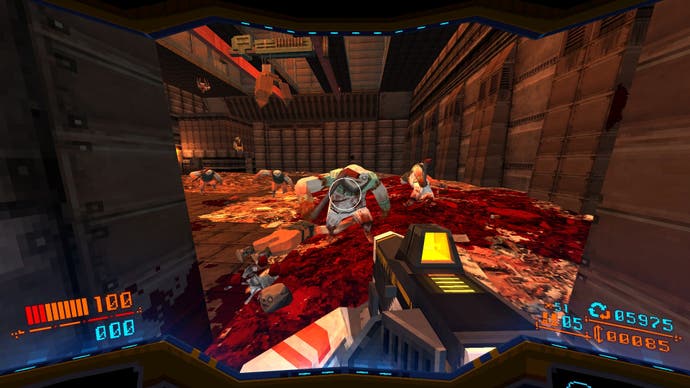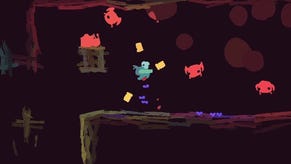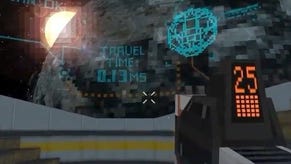Strafe review
Two steps sideways, one step back.
What's the most important component of a good FPS? Is it violence? No. Is it smart level design? That can certainly make your shooter interesting and memorable, but it isn't a prerequisite to enjoyment. Is it fast movement? Again, that won't hurt your chances. But like all these other hallmark elements of FPS design, it isn't as fundamental as ensuring that your guns are fun to fire.
Go back to any of the classic shooters of the mid-90s, and you will find that no matter how badly the graphics have aged, how weird their control schemes are, the weapons they place in your pixelated hands feel absolutely fantastic. Doom's shotgun, Quake's Nailgun, Half Life's revolver, each of them is a masterclass in audio/visual feedback, a bucking, roaring, arm-juddering bringer of death. It's why whatever else they did right or wrong, you can go back to any of them today and still have a great time from the first shot onwards.
This is exactly what I did while playing through Strafe, because from the moment I entered Pixel Titans' procedurally generated love-letter to 1996, my hands and my brain were telling me something wasn't right. The sensation was so unsettling that I had to check I wasn't misremembering my own misspent youth turning big brown polygons into smaller red polygons. So I went back, and undertook a crash-course in the formation of the first-person shooter, 1993 to 1998.

It confirmed my suspicions. From its tongue-in-cheek tutorial to its fountains of gore, Strafe presents a convincing facsimile of a golden-age FPS. Meanwhile, it underpins this aesthetic with a more modern structure, featuring procedurally generated levels and brutally unforgiving permadeath. But none of its innovations or achievements can make up for the fact that it gets the guns wrong.
Before I slice my chainsaw through Strafe's pulsating jugular, let's talk about what it does right, because a lot of love has gone into this game, and I want to like it more than I do. Strafe has you don the helmet of a nondescript soldier-slash-explorer fellow (or fellette, Strafe lets you select gender) travelling through some dark corner of uninhabited space. There is a more specific backstory than this, but in true mid-90s fashion the developers don't particularly care about explaining it. You won't either. From the moment you teleport into the in the belly of the decrepit Starship Icarus, Strafe is a straightforward, relentless bloodbath.
Strafe's crowning achievement is how it transforms technical limitation into a distinct style. Its blocky environments and lumpen enemies are rendered in bright and bold colours, and subtly infused with more modern technologies, such as ragdoll physics and Strafe's unique UBER-GORE system, which paints the environments in levels of blood and giblets that would have caused even the most trick of Intel 486 PCs to violently implode.
Almost as impressive are Strafe's procedural generation algorithms. While each level is randomly assembled, it doesn't look like it. Commencing inside the Icarus, whose narrow corridors and brick-like elevators evoke memories of Doom, Strafe busts out into terrifying alien gorges with glowing acid lakes, and a subterranean research facility connected by its own underground railway. Its structured as a guided tour through FPS history, referencing everything from Duke Nukem to Half Life. Strafe even manages to incorporate traps into its procedural levels, where picking up a keycard will trigger a bunch of walls to open up back along the route you came, spilling more enemies into the level. That's clever. Bloody annoying, but clever.

The later levels are particularly enjoyable to explore. But I wonder how many people will reach them. As well as being an FPS, Strafe is also a roguelike, and it is a fearsome one at that. The first stage throws wrench-wielding madmen and plasma-spitting spiderbots at you in their dozens, while health and armour are alarmingly sparse. To put its difficulty into perspective, a clean run through of Strafe would take you roughly two hours. It took me seven to escape from the Icarus for the first time. Yet after that point things become much more manageable, which presents something of an imbalance. You know what else shooters had back in 1996? Difficulty levels! They may have gently ribbed you for picking an easier option, but at least they asked for your consent to Hurt You Plenty.
As well as uneven pacing, the collision between Strafe as a roguelike and Strafe as a shooter results in some other curious decisions. A few of these work well. For example, every two levels you arrive at a shop that lets you buy permanent upgrades, ranging from deployable traps (not very useful) to faster running speed (essential for survival). Other ideas are less successful. Instead of straightforward pickups, Strafe sports a simple crafting system. Some enemies drop scrap that can be collected and forged into ammo or armour at crafting machines. I found this system antithetical to the game's pace, as it meant I had to keep one eye on how much scrap I had, and regularly needed to backtrack to the nearest machine when I wanted to craft something.
Weirdest of all, at the start of your run you pick one of three guns to wield, a shotgun, a machine gun, or a railgun. That's the gun you will use against 90 per cent of the enemies you shoot. All the other weapons you pick up are disposable. The idea is that you upgrade your starting weapon as you go along, but I often found these upgrades to be less useful than the vanilla firing mode. A particularly bizarre upgrade for the shotgun has it fire three bouncing grenades, which given that Strafe demands precision with almost every shot, is like using a jackhammer to strip wallpaper. Moreover, Strafe is often so intense and the price of death so steep that I was reluctant to experiment with other weapons in case they threw off my timing.

Ultimately though, none of this matters, because Strafe's weapons are, sadly, rubbish. I think the issue stems mainly from sound design. You can tell everything about an FPS from its implementation of the shotgun, and Strafe's boomstick sounds like a chaffinch sneezing when it's been shot. Even explosions severely lack force, and consequently rockets and grenades are nothing like as satisfying as they should be.
Strafe looks and moves like a 90s shooter, but it doesn't sound like a nineties shooter. It lacks the concussive depth of those early icons, the thundering gunfire and crunchy impacts that transform a fairground shooting gallery into a desperate battle for survival.
All this adds up to a game that doesn't feel like a 90s shooter either. Strafe suffers from a kind of weightlessness, an inertia that means although you see the effects of your rampage splattered all around you, you don't feel it in the same way. The best shooters have guns that rattle up your mouse-arm and into your soul, and for all its smart ideas and lavish retro stylings, Strafe struggles to make much of an impact.






